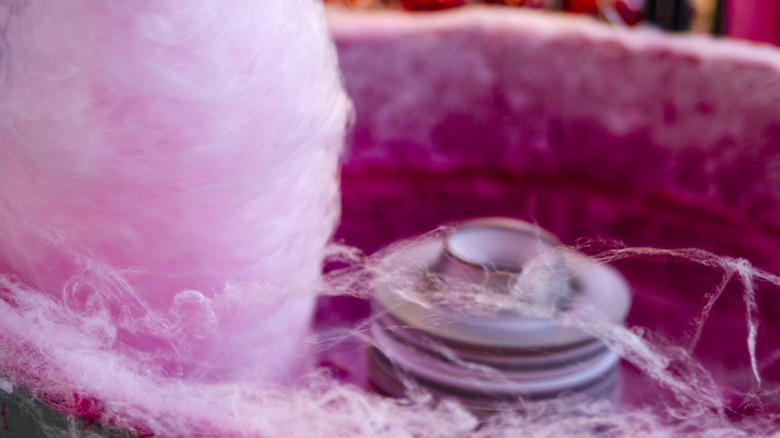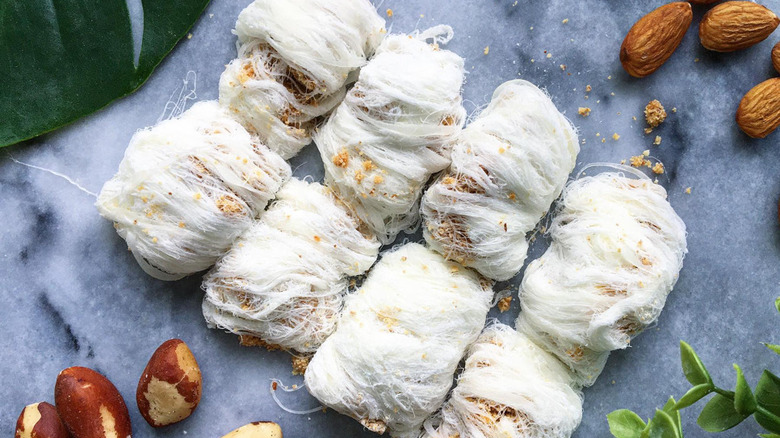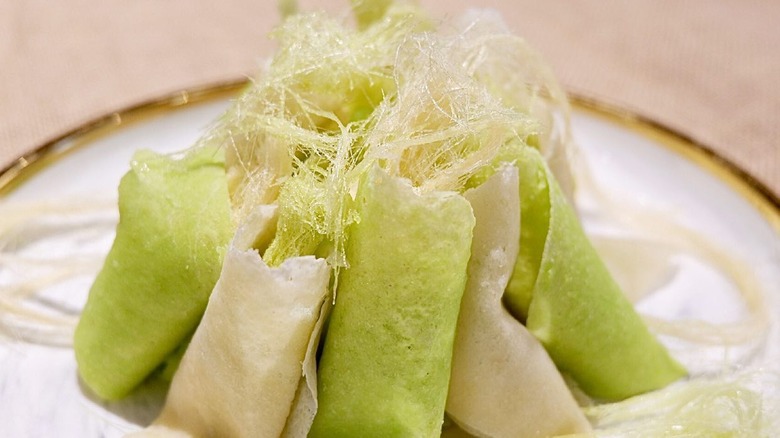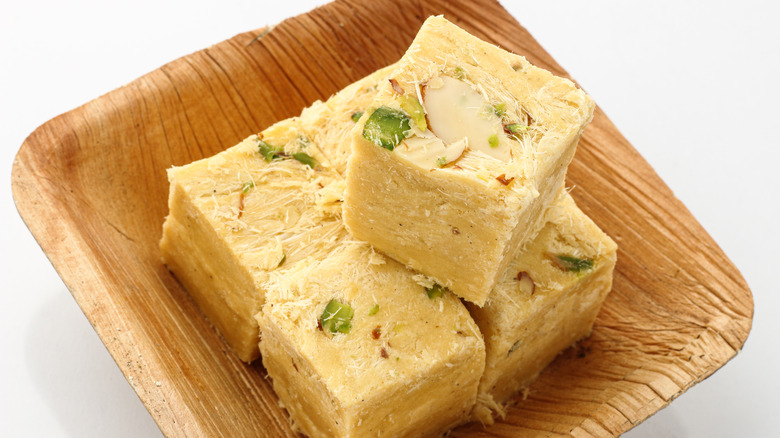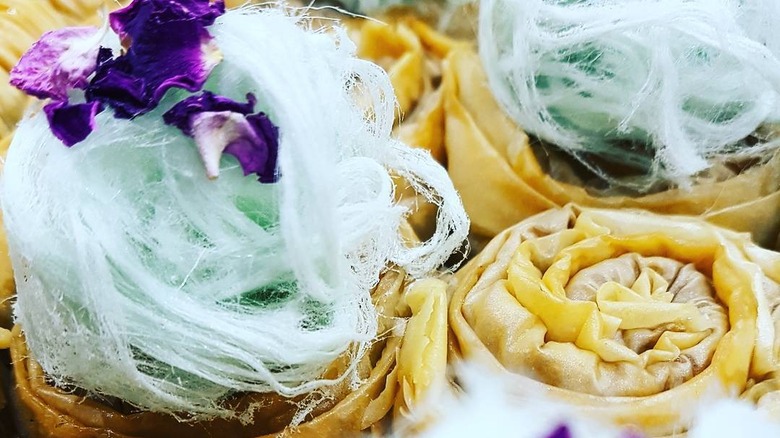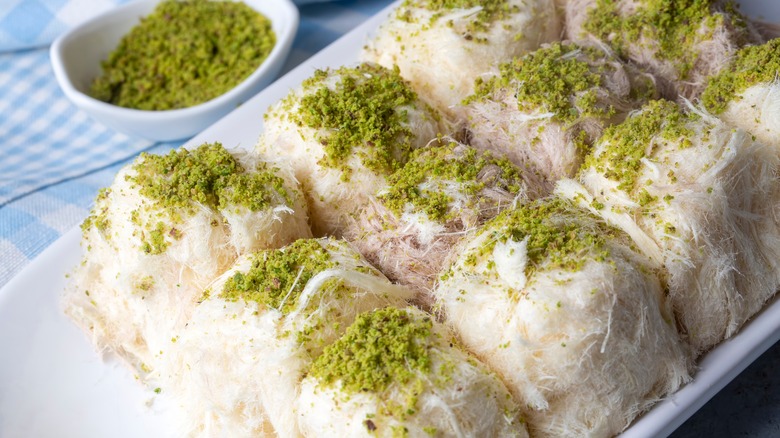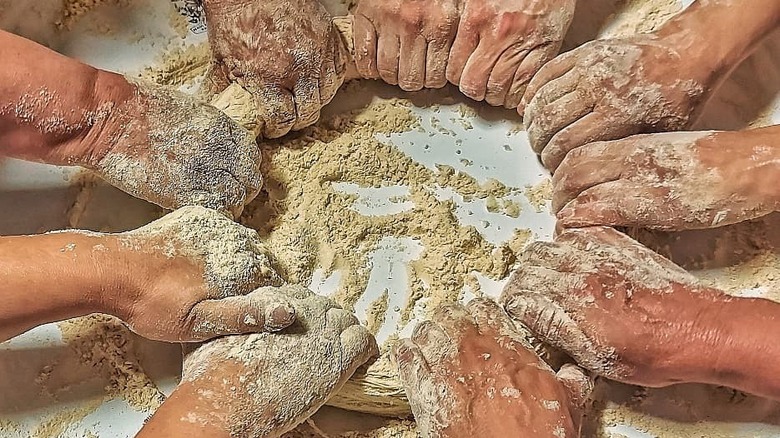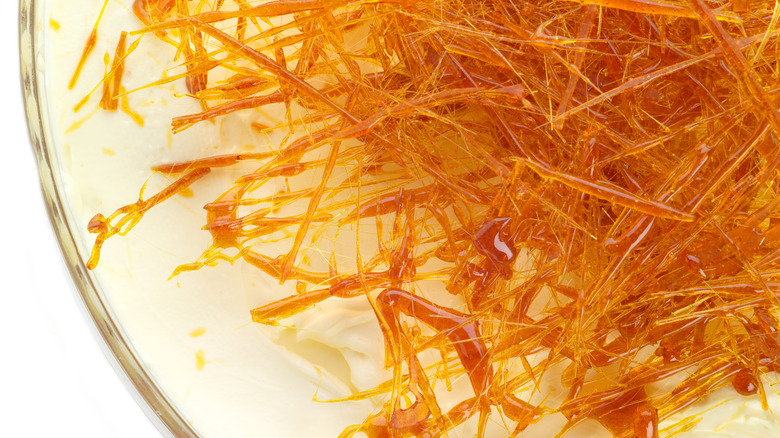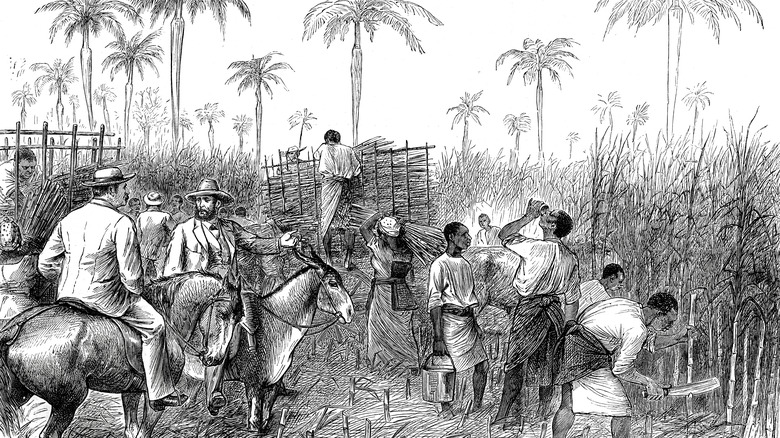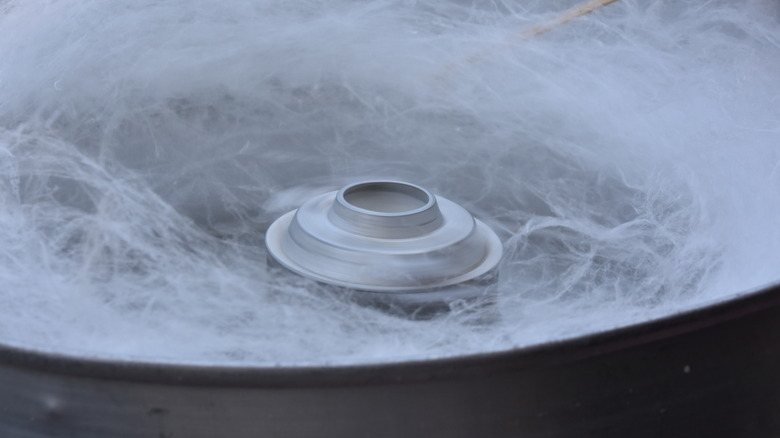The Ancient, Global History Of Cotton Candy And Its Predecessors
Though cotton candy as we know it today didn't appear until the turn of the 20th century, it has many ancient predecessors that speak to a worldwide penchant for textural delights and a universal human sweet tooth. Earlier forms of this treat were only accessible to the very rich who could afford luxury confections, though the elite often indulged to the detriments of their health. Cavities were once considered an exclusively royal affliction and consequently regarded as godly punishment for gluttony. Tooth decay was a particular problem for England's Queen Elizabeth I and France's King Louis XIV – Queen Elizabeth's rotten teeth were completely black, and Louis XIV was advised to have all his decaying teeth extracted. Though the royals who suffered from obesity, diabetes, and dental problems wouldn't have known this, Rutgers University asserts that a sweet tooth is not unlike a cocaine addiction. Perhaps this is why there are numerous dentists who feature in cotton candy's rise to popularity — if not to inspire oral hygiene, then perhaps to drum up more business.
Beyond the havoc it wreaked on the royals of the past, today's sweet, charmingly sticky fairground snack has a backstory that runs parallel to sugar's lengthy history, rooted in the tumultuous progression of an exploitative global sugar trade. Though the cottony hues of pastel pink and blue may only have gone mainstream in the last hundred years, cotton candy has been around for longer than recorded history — it's just had a few different names.
Chinese dragon beard candy
Dragon's Beard is a Chinese confection that dates back to the Han dynasty. If it wasn't named for the dragon, which was the symbol of imperial rule since emperors were known as the dragon, then one popular legend suggests the candy was named for the wisps of sugar that stuck to one emperor's face when he first tried the dessert, resembling the whiskers of a dragon.
Though the base ingredients are simple, this ancient cotton candy is a highly complex endeavor to successfully create and remains an important historical handcraft. The process of making it requires first boiling sugar, then letting it cool into a gel. Next, the gel is stretched into a ring, then folded in on itself numerous times until it's separated into thousands of fine, wispy hairs. This ancient method of creating Dragon Beard's silken structure is a primitive version of the same technology that contemporary cotton candy machines use, relying simply on repetitive handiwork rather than centrifugal force.
What differentiates Dragon's Beard is the filling within the silken strands — peanuts, sesame seeds, and shredded coconut, or some combination of the three, are popular choices. This delicacy, once available only in the highest echelons of Imperial China, is now a common street food. Dragon's Beard also directly inspired a Korean variant known as kkul-tarae, or Korean court cake, which is nearly identical in flavor and appearance.
Thai roti sai mai
In the 7th century, mercenaries from Iran, India, Pakistan, Indonesia, and China ventured into the Thai Kingdom. The cornerstone of these nations' culinary and cultural legacy in Thailand is roti sai mai, a crunchy, primitive cotton candy dessert with Islamic influences that incorporates methods and ingredients popularized by these visiting nations. The dessert is said to have first appeared in Thailand in the ancient capital of Ayutthaya, where Muslim vendors sold it in the streets. Roti sai mai consists of strands of candy floss wrapped in a green and lightly salted crepe-like roti. The result is a harmonious melange of many flavors, a Thai cotton candy burrito melding sweet with savory for maximum deliciousness.
The traditionally green roti gets its color from pandan leaves, which contribute notes of coconut and vanilla to the flavor profile. The candy floss is made the same way as many of its predecessors with a combination of flour, sugar, water, and oil that get boiled together and then stretched — pulling the floss into strands requires a great deal of strength. Today roti sai mai is a popular street food as a convenient portable snack.
Indian soan papdi
India is another nation with ancient claims to a cotton candy predecessor in the form of two special occasion sweets that have a similar floss-like texture. Soan papdi – also called patisa, san papri, sohan papdi, shonpapdi, and sometimes known as Indian candy floss — is made from ghee, flour, and sugar and seasoned with cardamom. Though the origin of this sweet is not officially known, and many contemporary versions use regular flour, traditional recipes use gram flour made from ground chickpeas. This means that the classic version of this dessert is naturally gluten-free. Soan papdi is especially popular during Diwali, the Festival of Lights that celebrates the triumph of light over darkness. This Indian treat is usually served in circular or square flakes and often topped with roasted pistachios, almonds, or crushed rose petals. The citrusy notes from the cardamom provide soan papdi's distinct flavor profile, and its texture is characteristically flakier than other floss candy desserts made from similar ingredients.
Feni is another Indian iteration of floss candy that is most popular during monsoon festivities to welcome the season's coming rain. This dessert is made from sugar, ghee, and wheat flour, from which the gluten enables the mixture to be pulled into thin strands without breaking. The result resembles sweet vermicelli with a melt-in-your-mouth consistency.
Iranian pashmak
Another ancient predecessor of cotton candy has its origins in Iran. Pashmak which translates to wool, has a similar cloudlike appearance and is colloquially known as Persian cotton candy. This confection, as sticky as it is sweet, is said to have originated in the ancient city of Yazd. Though Yazd's major export during ancient times was silk, it was primely situated at the intersection of China and India's trade routes along the silk road; these two empires, for many years, were the only two countries exporting sugar since they were then the only countries growing sugarcane.
With easy access to this sweet, elite export, it's no wonder Yazd put its own creative spin on sugar's possibilities. The ingredients for pashmak are simple — flour roasted in butter and combined with caramelized sugar that's cooled into a molasses texture. This mixture is created much the same way as Dragon's Beard, by forming it into repeated rings until it separates into silken strands, but it is pashmak's nutty flavor from the roasted flour which makes this dessert unique. Popularly garnished with pistachios, pashmak is often treated as a garnish itself for ice creams, puddings, and even cakes. When served with nuts, watermelon, and pomegranates, it becomes a popular treat for Yalda Night — a winter solstice festival — and, at this time of year, is also prevalent in Turkey, Azerbaijan, and other surrounding areas of Iran.
Turkish pişmaniye
Taking inspiration from Iran's pashmak, Turkey has its own cottony confection that can be traced back to the 15th century. Also called string halva, stretched halva, and floss halva, pişmaniye is a Turkish sweet said to have originated in Kocaeli, slightly southeast of Istanbul. The process and ingredients that go into producing this dessert are virtually the same as for pashmak, though this Turkish variety is often distinguished by the addition of one key ingredient for a unique flavor, tahini, a paste of sesame seeds which contributes to a stickier consistency and lends an even bolder, nuttier taste.
There are numerous claims to the etymology of pişmaniye. According to the Food Hog, one story is "the name derives from the word "pashm," meaning wool in Persian, another says that the name derives from the Coptic word "pis," meaning to mix flour with fat and "nani," meaning hair candy. However, the most popular story includes an urban legend featuring a local vendor and a chubby lady with whom the vendor fell in love. To get her attention, he designed this sweet just for her and called it "şişmaniye" meaning my fat lady in Turkish."
This bitter origin tale contrasts with the delightfully light and airy texture of the wooly strands that define this dessert.
A Balkan Tradition
Cotton candy's primeval origins continued migrating westward when neighboring Slavic countries took inspiration from Turkish pişmaniye. This phenomenon of roasting flour and sugar before pulling the mixture into strands has become a symbol of Bosnian heritage, and is known as ćetenija in Bosnia and Herzegovina. Following the same first step of roasting flour and crystalizing sugar, ćetenija has its own unique flavor that comes from adding lemon to the sweetener as it is heated.
This dessert is a dying art form, as its simple ingredients require a complex and labor-intensive manufacturing process that must employ many pairs of hands. This collaborative effort was, and still is, a popular winter pastime of Bosnian sitting parties called sijelo, during which guests take part in this delicate process that necessitates skillful coordination. The technique takes many hours to complete and was often accompanied by sevdah, traditional folk music. The resulting confection is soft and starchy, its flavor undoubtedly enhanced by the effort that goes into making it.
Even if it may not be as popular as it once was, ćetenija has a place of cultural significance as a dessert intended to bring people together. "Cetenija was the first example of a social network," according to Oslobodenje, the Bosnian national newspaper. As it "[connected] people before Facebook."
Spun Sugar, a Renaissance Predecessor
Cotton candy's European heritage can also be traced back to at least the 15th Century when spun sugar was the novelty of Renaissance Venice. Then the Republic of Venice, this sovereign state had the monopoly on the European sugar trade through its possession of Cyprus, an island just off the Turkish mainland that had a climate very well suited to growing sugarcane.
Whether Italy's claim to this version of the sweet came from Cyprus inheriting Turkish culinary customs, Venice finding inspiration from its mercantile connection to the Silk Road, or Venetian chefs simply dreaming up an indigenous innovation, Italian cooks transformed the concept of sugar strands into an extravagant art form. Rather than forming melted sugar into loops until it devolved into silken threads, they used forks to pull the caramelized sugar into fine, sticky strands, which were then draped over objects like bowls or broom handles and left to cool and crystallize. This practice ascended to an artistic apex once cooks began forming spun sugar into increasingly more complex shapes and edible sculptures. This phenomenon even attracted notable artists with the promise of a new and revolutionary edible medium to work with.
One of the most memorable occasions for serving spun sugar creations was a Venetian banquet for King Henry III of France in 1574. In addition to highlighting sugar sculptures, the celebration featured plates and utensils — a grand total of 1,286 pieces — that were also made entirely of sugar.
Triangle Trade Brought Sugar to America
Though sugar had been on the European radar since the Crusades, for centuries, it was more of a specialty commodity used as a medicine and occasional spice. But with sugar taking center stage as a new art form during the Renaissance, the desire for this delicacy increased exponentially. The emergence of a continental sweet tooth coincided fatefully with European ventures across the Atlantic, culminating in a perfect storm of location-hunting for land and labor to supply this growing demand.
Sugar was the primary impetus behind the development of the transatlantic triangle trade route, which peaked in the late 1700s. After decimating indigenous American populations with widespread violence and European diseases, colonizers sought another source of cheap labor and began to import slaves from Africa to cultivate the sugarcane that thrived in the humid environments of this New World locale. Through the exploitative labor of this new plantation system, sugar became a highly viable international cash crop. By the 18th century, sugar made up a third of the European economy.
The Bittersweet Rise in Sugar Availability
After the United States bought Louisiana from the French in 1803 during the infamous Louisiana Purchase, the region attracted refugees from the recent Haitian revolution that had contributed to this very exchange in Louisiana's ownership. Already well-versed in the sugar trade, Haiti, while it was the French colony of Saint-Domingue, was the most profitable colony in the Americas, and its emigres to Louisiana applied their know-how in sugarcane cultivation to the lowlands and marshes of the region.
Expanding the sugar trade into the bayou inspired another surge in demand for forced labor, and the conditions slaves faced here were especially inhumane. Crushed limbs and scalded skin were not uncommon occupational hazards in the sugar refineries that popped up to process this sugarcane, prompting one enslaved witness, Henry Goings, to conclude, "It was death to those who worked at the mill."
The more widespread availability of sugar directly correlates with a rise in slavery investments. Louisiana and a few other states sold state bonds that funded slave-backed credit on a large scale via both foreign and domestic investors. This system caused slavery in regions of sugar production to increase by 86% in the 1820s, enabling the price of sugar to drop substantially by the 1830s. This dark moment in American industry coincides with the rise in a growing abolition movement, which by the 1830s had attracted many women to the cause. Among these women was Elizabeth Heyrick, an English Quaker abolitionist who led a mass sugar boycott.
Sugar Trickles Down from Luxury Status
Quakers spearheaded multiple sugar boycotts during the 18th and 19th centuries. However, this antislavery movement grew as more members of both the English and American Quaker communities began to draw attention to the barbaric conditions of enslaved workers.
Though sugar prices skyrocketed during the events of the Civil War when enslaved persons were able to escape or abandon sugar plantations and burn many to the ground, the industry recovered in the following decades, causing sugar prices to level again. This returned sugar to widespread availability, reflected in a number of cookbooks from the late 1800s that offered visual inspiration and detailed instructions to revive that Renaissance penchant for works of pure-sugar art. INDY Week mentions Henry Weatherly's "A Treatise on the Art of Boiling Sugar" from 1884, for example, which encourages budding household confectioners that "Spun sugar can also be made into vases, ships, etc. by making the parts separate and afterward sticking them together with some of the sugar used in the process."
Sweets and Circuses, a World's Fair Introduction
Cotton candy, as we've come to know it today, reached widespread popularity after enterprising dentist William Morris and confectioner John C. Wharton made innovative use of abundant sugar by creating a machine that took spun sugar to the next level. This machine eliminates the need for tedious handiwork by harnessing chemistry that, within minutes, could transform sugar crystals into billowy clouds of sweetness. The spinning head of this machine heated up sugar until it melted, whereupon the centrifugal force of the spinning pushed the sugar through a mesh screen, which transformed the sugar into thin silky strands. This same technology is not all that different from the commercial way cotton candy is made today.
This original electric sugar spinning machine was patented in 1897 and had its world debut at the Paris Exposition of 1900. But this invention and the sweet fluff it generated didn't truly take off until the St. Louis World's Fair in 1904. The success of this confection at the fair reflected America's growing penchant for sweet things — Morris and Wharton sold over 68,000 servings of what they called "fairy floss" and made today's equivalent of $370,000. But the setting, which was officially called the Louisiana Purchase Exposition to commemorate the 100th anniversary of the eponymous Purchase, serves as a poignant reminder of the complicated history surrounding America's demand for sugar, and the barbaric treatment of enslaved people that enabled the country to indulge its sweet tooth.
A Legal Loophole Coined the Term Cotton Candy
Fairy floss was so popular at the World's Fair that Morris and Wharton decided to expand their business. They created the Electric Candy Company, which put their spun sugar machine on the market, further proliferating fairy floss by granting others the ability to make their own. While the American take on melt-in-your-mouth sugar was referred to interchangeably as spun sugar or fairy floss at the turn of the century, the name cotton candy was introduced in the 1920s by another enterprising individual working around Morris and Wharton's patent to make a profit of his own. Josef Lascaux was able to sell his product, virtually the same as fairy floss, by simply calling it another name.
Lascaux chose cotton candy because the treat reminded him of the cotton grown in his home state of Louisiana. This likely unintentional nod to the slave system that once made both cotton and sugar an impactful aspect of the Louisiana economy is not the only irony of Lascaux's entrance into the sweets scene. He, too, was a dentist. While it's true that a serving of cotton candy actually contains less sugar than we might think — just about 1 tablespoon, which is less than what's in a can of soda — it still isn't necessarily good for the teeth. But perhaps its proliferation was strategic. Though encouraging sweets likely didn't help Morris or Lascaux's dental patients, it was probably good for business in more ways than one.
Cotton Candy as the Future
While cotton candy has remained a relatively frivolous commodity since ancient times, more recent history has enabled the science behind its production to have even more significance than its sweetness. Though the dentists that brought this confection to mainstream popularity a hundred years ago may not have spread sweets to the masses with the intention of promoting healthfulness, today's biomedical engineers have recently commandeered the chemistry behind cotton candy as a means of remedying life-threatening circumstances. The former carnival staple may provide an important gateway to producing effective artificial organs and more quickly healing serious wounds.
Leon Bellan, assistant professor of mechanical engineering at Vanderbilt University, is striving to manufacture fiber networks to serve as a prototype of the capillary systems needed to sustain such artificial organs. "I decided to give the cotton candy machine a try," he told Science Daily. "It turned out that it formed threads that were about one tenth the diameter of a human hair — roughly the same size as capillaries — so they could be used to make channel structures in other materials."
But even if the structure of cotton candy threads may be optimal for simulating artificial capillaries, this medical use will require a different non-water-soluble ingredient, as sugar itself would dissolve when in contact with bodily fluid. The technology is still in the very early stages, but if successful, the same mechanics that produce cotton candy could have a redemptive second act by saving countless lives.
